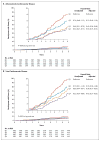HDL cholesterol efflux capacity and incident cardiovascular events
- PMID: 25404125
- PMCID: PMC4308988
- DOI: 10.1056/NEJMoa1409065
HDL cholesterol efflux capacity and incident cardiovascular events
Abstract
Background: It is unclear whether high-density lipoprotein (HDL) cholesterol concentration plays a causal role in atherosclerosis. A more important factor may be HDL cholesterol efflux capacity, the ability of HDL to accept cholesterol from macrophages, which is a key step in reverse cholesterol transport. We investigated the epidemiology of cholesterol efflux capacity and its association with incident atherosclerotic cardiovascular disease outcomes in a large, multiethnic population cohort.
Methods: We measured HDL cholesterol level, HDL particle concentration, and cholesterol efflux capacity at baseline in 2924 adults free from cardiovascular disease who were participants in the Dallas Heart Study, a probability-based population sample. The primary end point was atherosclerotic cardiovascular disease, defined as a first nonfatal myocardial infarction, nonfatal stroke, or coronary revascularization or death from cardiovascular causes. The median follow-up period was 9.4 years.
Results: In contrast to HDL cholesterol level, which was associated with multiple traditional risk factors and metabolic variables, cholesterol efflux capacity had minimal association with these factors. Baseline HDL cholesterol level was not associated with cardiovascular events in an adjusted analysis (hazard ratio, 1.08; 95% confidence interval [CI], 0.59 to 1.99). In a fully adjusted model that included traditional risk factors, HDL cholesterol level, and HDL particle concentration, there was a 67% reduction in cardiovascular risk in the highest quartile of cholesterol efflux capacity versus the lowest quartile (hazard ratio, 0.33; 95% CI, 0.19 to 0.55). Adding cholesterol efflux capacity to traditional risk factors was associated with improvement in discrimination and reclassification indexes.
Conclusions: Cholesterol efflux capacity, a new biomarker that characterizes a key step in reverse cholesterol transport, was inversely associated with the incidence of cardiovascular events in a population-based cohort. (Funded by the Donald W. Reynolds Foundation and others.).
Figures


Comment in
-
Atherosclerosis: cholesterol efflux capacity-a new biomarker for cardiovascular risk?Nat Rev Cardiol. 2015 Jan;12(1):2. doi: 10.1038/nrcardio.2014.198. Epub 2014 Dec 2. Nat Rev Cardiol. 2015. PMID: 25445136 No abstract available.
-
Biomarkers: Cholesterol efflux capacity--inverse association with incident cardiovascular disease.Nat Rev Endocrinol. 2015 Feb;11(2):64. doi: 10.1038/nrendo.2014.217. Epub 2014 Dec 9. Nat Rev Endocrinol. 2015. PMID: 25488484 No abstract available.
-
HDL cholesterol efflux capacity and cardiovascular events.N Engl J Med. 2015 May 7;372(19):1871-2. doi: 10.1056/NEJMc1503139. N Engl J Med. 2015. PMID: 25946297 No abstract available.
-
HDL cholesterol efflux capacity and cardiovascular events.N Engl J Med. 2015 May 7;372(19):1869. doi: 10.1056/NEJMc1503139. N Engl J Med. 2015. PMID: 25946298 No abstract available.
-
HDL cholesterol efflux capacity and cardiovascular events.N Engl J Med. 2015 May 7;372(19):1869. doi: 10.1056/NEJMc1503139. N Engl J Med. 2015. PMID: 25946299 No abstract available.
-
HDL cholesterol efflux capacity and cardiovascular events.N Engl J Med. 2015 May 7;372(19):1870-1. doi: 10.1056/NEJMc1503139. N Engl J Med. 2015. PMID: 25946300 No abstract available.
-
HDL cholesterol efflux capacity and cardiovascular events.N Engl J Med. 2015 May 7;372(19):1871. doi: 10.1056/NEJMc1503139. N Engl J Med. 2015. PMID: 25946301 No abstract available.
-
Cholesterol efflux capacity as a novel biomarker for incident cardiovascular events: has high-density lipoprotein been resuscitated?Circ Res. 2015 May 8;116(10):1646-8. doi: 10.1161/CIRCRESAHA.115.305938. Circ Res. 2015. PMID: 25953923 No abstract available.
References
-
- Stone NJ, Robinson J, Lichtenstein AH, et al. ACC/AHA Guideline on the Treatment of Blood Cholesterol to Reduce Atherosclerotic Cardiovascular Risk in Adults: a report of the American College of Cardiology/American Heart Association Task Force on Practice Guidelines. Circulation. 2014;129(Suppl 2):S1–S45. Erratum, Circulation 2014;129:Suppl 2:S46–S48. - PubMed
-
- Boden WE, Probstfield JL, Anderson T, et al. Niacin in patients with low HDL cholesterol levels receiving intensive statin therapy. N Engl J Med. 2011;365:2255–67. Erratum, N Engl J Med 2012;367:189. - PubMed
-
- Barter PJ, Caulfield M, Eriksson M, et al. Effects of torcetrapib in patients at high risk for coronary events. N Engl J Med. 2007;357:2109–22. - PubMed
-
- Schwartz GG, Olsson AG, Abt M, et al. Effects of dalcetrapib in patients with a recent acute coronary syndrome. N Engl J Med. 2012;367:2089–99. - PubMed
-
- The HPS2-THRIVE Collaborative Group. Effects of extended-release niacin with laropiprant in high-risk patients. N Engl J Med. 2014;371:203–12. - PubMed
Publication types
MeSH terms
Substances
Grants and funding
LinkOut - more resources
Full Text Sources
Other Literature Sources
